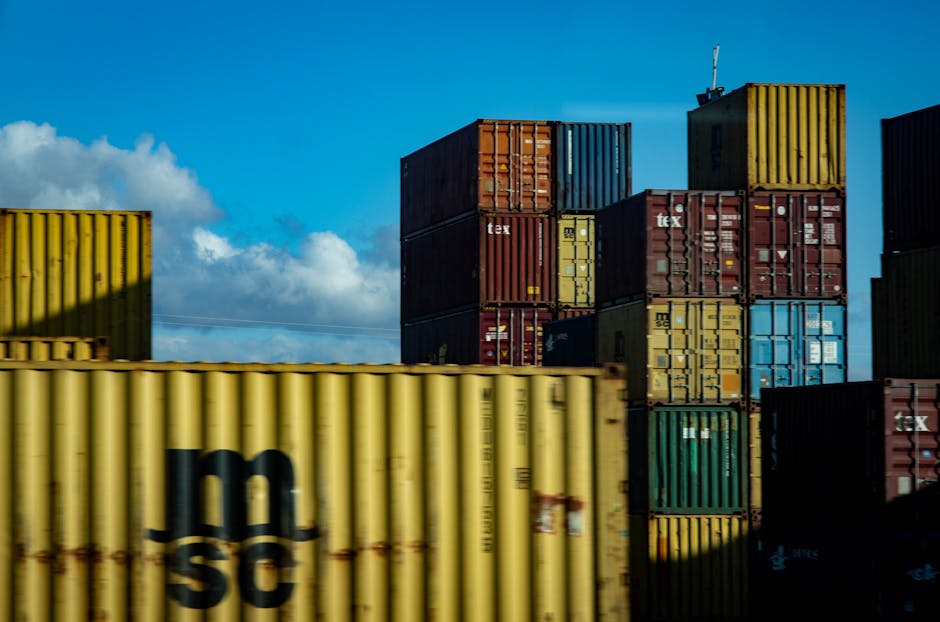Why Metal Storage Containers Are Essential for Secure Asset Protection
Metal storage containers offer the best protection for everything from industrial equipment to precious metals. Whether securing business inventory, personal belongings, or investment-grade assets, understanding your options is key.
Key Benefits of Metal Storage Containers:
- Durability - Steel and aluminum construction withstands decades of use.
- Security - Heavy-gauge metal and locking systems deter theft.
- Weather Resistance - Wind and water-tight designs protect contents.
- Versatility - Available in sizes from small tins to 40-foot shipping containers.
- Fire and Pest Protection - Metal resists fire and blocks rodents and insects.
The global metal packaging market is projected to grow from $119.1 billion in 2023 to $157.8 billion by 2030, reflecting increasing demand across all industries.
For investors, standard storage often falls short. With two decades of experience on Wall Street structuring defensive strategies, I've learned that proper storage is the foundation of any sound investment plan. This principle is just as crucial for precious metals as it is for institutional portfolios, starting with the right protective infrastructure.
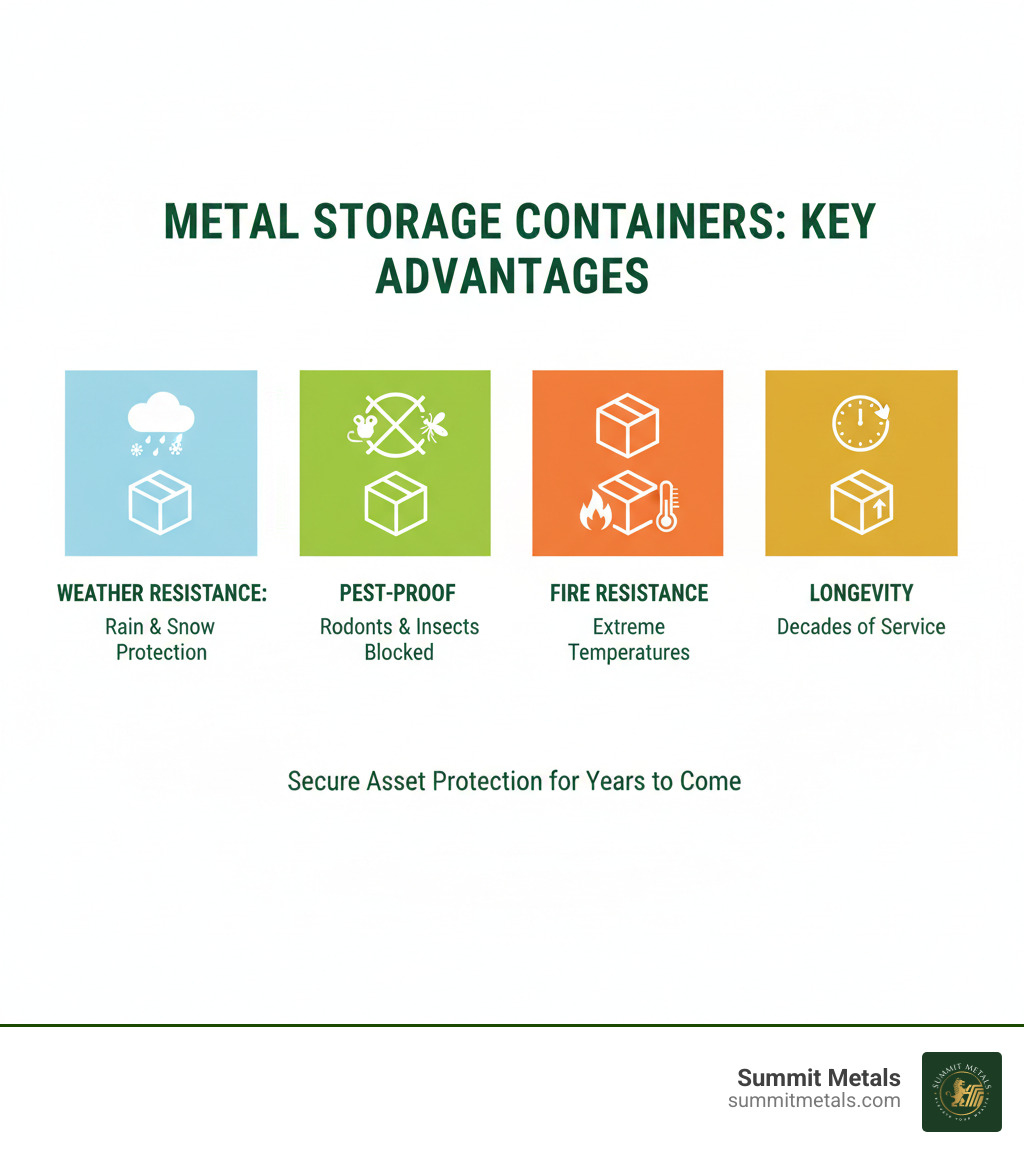
From Cargo to Keepsakes: A Roundup of Metal Container Types
The world of metal storage containers ranges from massive steel boxes to small household tins. Understanding this variety helps you find the right solution.
Large-Scale Industrial and Commercial Storage
Shipping containers, or Conex boxes, are the steel workhorses of global trade. Standard sizes include 10-foot containers for tight job sites, 20-foot containers for small business needs, and 40-foot containers for moving massive amounts of goods. These containers follow strict international standards for seamless transport.
Beyond shipping, modified shipping containers are now trendy coffee shops, retail spaces, homes, and offices. The same steel that protects cargo on the ocean now protects a business or a living room.
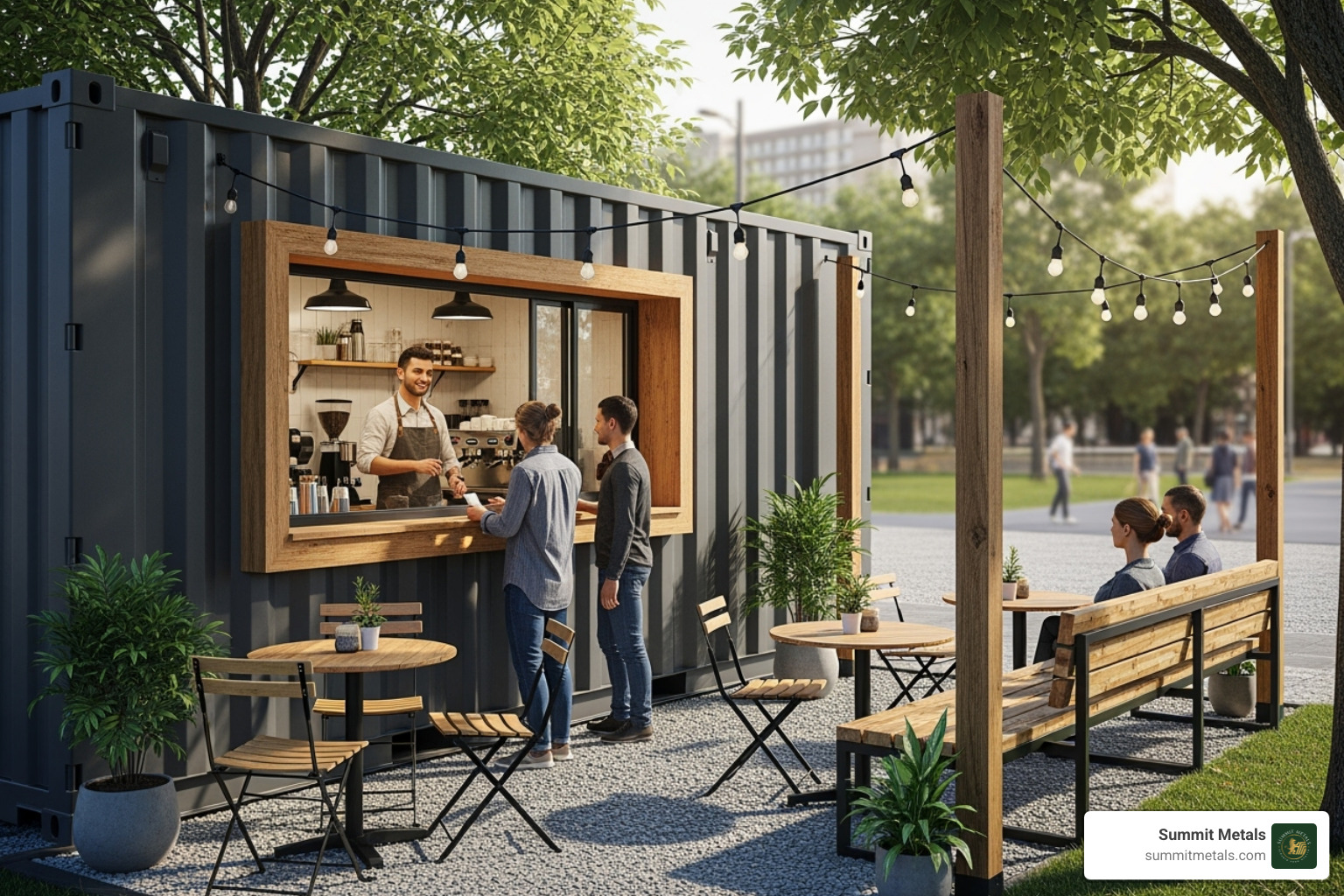
For warehouse operations, Stillage Metal Bins are essential for material handling. These industrial containers can hold up to 6,000 pounds and stack six high when loaded, keeping production lines flowing.
Mid-Size and Specialized Commercial Containers
Refrigerated containers (reefers) are climate-controlled units that keep produce, flowers, and pharmaceuticals safe during transport. Insulated containers act like a heavy-duty thermos, protecting goods from temperature swings without active cooling. Companies like On-Site Storage Solutions provide these specialized units.
Innovations like collapsible containers and flatpack units solve the problem of transporting empty containers by folding down, which slashes return transportation costs.
Home, Office, and Small-Scale Storage
Metal storage containers are also practical for everyday use. Galvanized steel shelves organize garages, while stainless steel canisters keep kitchen staples fresh. Wire baskets and tin boxes help organize pantries and documents. Metal offers durability where plastic cracks and wood warps.
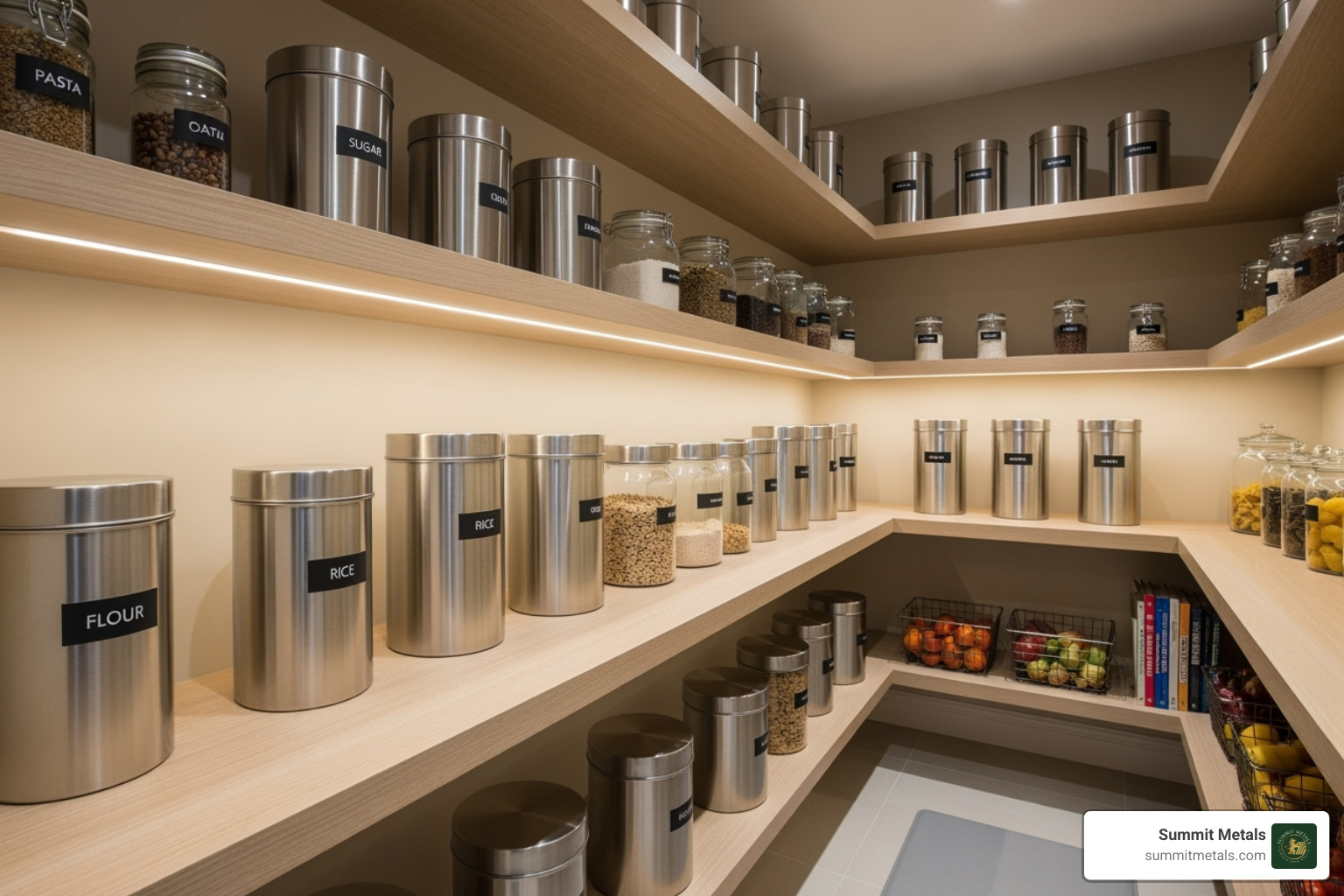
Metal also adapts to your style, from modern stainless steel in kitchens to vintage tins in home offices. From 40-foot shipping containers to small desk organizers, metal storage serves at every scale.
The Unbeatable Advantages of Metal Storage
When storing valuable items, the container's material is critical. Metal consistently outperforms plastic or wood, offering protection that lasts for decades and providing true peace of mind.
Durability and Weather Resistance
Steel is the most widely used metal for storage containers due to its strength and affordability. Standard industrial units can handle loads up to 6,000 pounds. To combat corrosion, galvanized steel is coated in zinc, acting as armor against rust and making it perfect for outdoor use.
For even greater protection, many containers feature a powder coating finish. This delivers 60% greater resistance to solvents, 74% better protection against salt spray, and 94% improved impact resistance compared to standard paint. It's also more environmentally friendly. For outdoor storage, look for a Wind and Water Tight (WWT) rating, which guarantees contents stay dry.
Here's how the materials compare:
| Feature | Metal | Plastic | Wood |
|---|---|---|---|
| Durability | Excellent (high strength, impact resist.) | Good (can crack/shatter) | Fair (prone to rot, pests, splintering) |
| Security | Excellent (hard to breach, lockable) | Fair (can be cut, less secure locks) | Poor (easily broken, vulnerable to pests) |
| Weather Resist. | Excellent (WWT, rust-resistant coatings) | Good (waterproof, UV can degrade) | Poor (rots, warps, absorbs moisture) |
| Cost | Moderate to High (long-term value) | Low to Moderate (good short-term value) | Low (often cheapest upfront) |
| Lifespan | Decades (with proper maintenance) | 5-15 years (degrades with UV, impact) | 1-10 years (requires significant upkeep) |
While the upfront cost may be higher, metal's longevity provides superior long-term value.
Best Security and Protection
Metal storage containers offer multiple layers of defense. They are completely pest-proof, unlike wood or plastic. Metal also provides substantial fire resistance, which could mean the difference between preservation and total loss for valuable items. The impact resistance of steel protects against accidents, weather, and tampering.
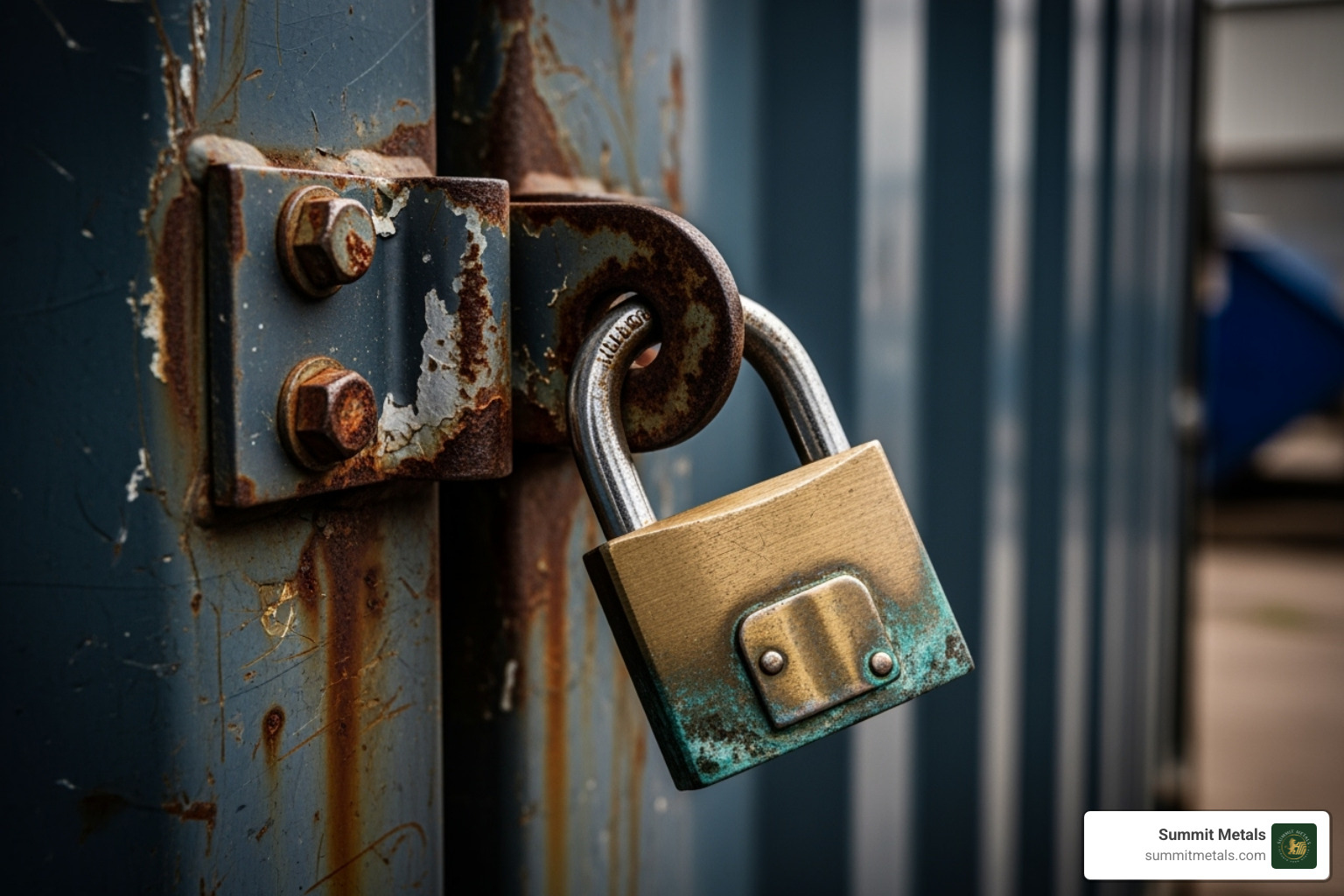
Metal containers accommodate heavy-duty padlocks and advanced security systems that would tear through other materials. For investors building wealth through precious metals—perhaps using a consistent strategy like Autoinvest to accumulate gold and silver like a 401(k)—this level of security is essential. Buying the metal is only half the battle; protecting it is just as important. For more on securing your investments, explore The Ins and Outs of Precious Metals Storage Options.
Buyer's Guide: How to Choose the Right Metal Storage Container
Choosing the right metal storage container means matching the container to its purpose. This guide will help you make an informed decision.
Key Factors to Consider
- Size and Capacity: Assess what you're storing to avoid buying a container that's too large or small. Consider both dimensions and weight capacity.
- Material Choice: Steel is the strong, cost-effective standard. Aluminum is a lighter, corrosion-resistant but pricier alternative. Galvanized steel offers a great balance of strength and rust protection, ideal for outdoor use.
- Condition Grades: For shipping containers, "One-Trip" units are nearly new and offer the longest lifespan. "Cargo Worthy" containers are certified for shipping and are structurally sound. "Wind and Water Tight" (WWT) units are leak-proof and cost-effective for stationary storage. "As Is" is the budget option but may require repairs.
- Security Features: Look for heavy-duty doors, secure latches, and provisions for robust padlocks. Welded seams and strong corner castings add structural integrity and security.
- Cost vs. Value: A metal container's higher upfront cost is offset by decades of service and superior protection, offering better long-term value than cheaper plastic or wood alternatives.
Before you buy, ask your supplier about dimensions, material, condition, security features, delivery costs, and maintenance requirements.
Understanding Quality in Metal Storage Containers
Look beyond the surface to assess true quality:
- Gauge of Steel: Lower gauge numbers mean thicker, stronger steel. Heavy-duty containers use lower gauge steel for critical structural components.
- Floor Construction: Most shipping containers have 1.25-inch wooden floors. Industrial bins may use various steel floors. Ensure the floor is solid and suited for your needs.
- Door Seal Quality: Check the rubber gaskets around the doors. Robust, well-maintained seals are crucial for keeping moisture, dust, and pests out.
- Frame Integrity: The frame bears the load and ensures longevity. Inspect it for rust, bending, or damage before purchasing a large container.
- Cargo Worthy Certification: This certification verifies a shipping container meets international standards for safe transport, confirming its structural integrity.
Understanding these markers helps ensure your investments are protected. For investors using our Autoinvest program to build a precious metals portfolio, evaluating storage quality is as vital as understanding the metals. We offer detailed guidance on precious metals storage options and fees to help you protect your wealth.
Specialized Storage for High-Value Assets: Protecting Your Investments
When storing precious metals, a standard shipping container is not enough. At Summit Metals, we know that gold and silver require a specialized approach to preserve their value.
Why standard metal storage containers aren't enough for bullion
Standard containers fail to protect bullion for several reasons:
- Corrosion Risk: They don't prevent environmental contaminants that can tarnish silver or cause "milky spots," which reduces value.
- Improper Sizing: Generic containers allow coins and bars to shift and scratch, diminishing their numismatic and resale value.
- Lack of Discretion: A large container on your property draws unwanted attention to your holdings.
- Climate Fluctuations: Changes in temperature and humidity can negatively impact metals, especially silver, over time.
For a deeper dive into protecting silver, see our guide: From Eagles to Ingots: Your Guide to Storing All Types of Silver.
Purpose-Built Containers for Precious Metals
Fortunately, specialized metal storage containers are engineered to solve these problems.
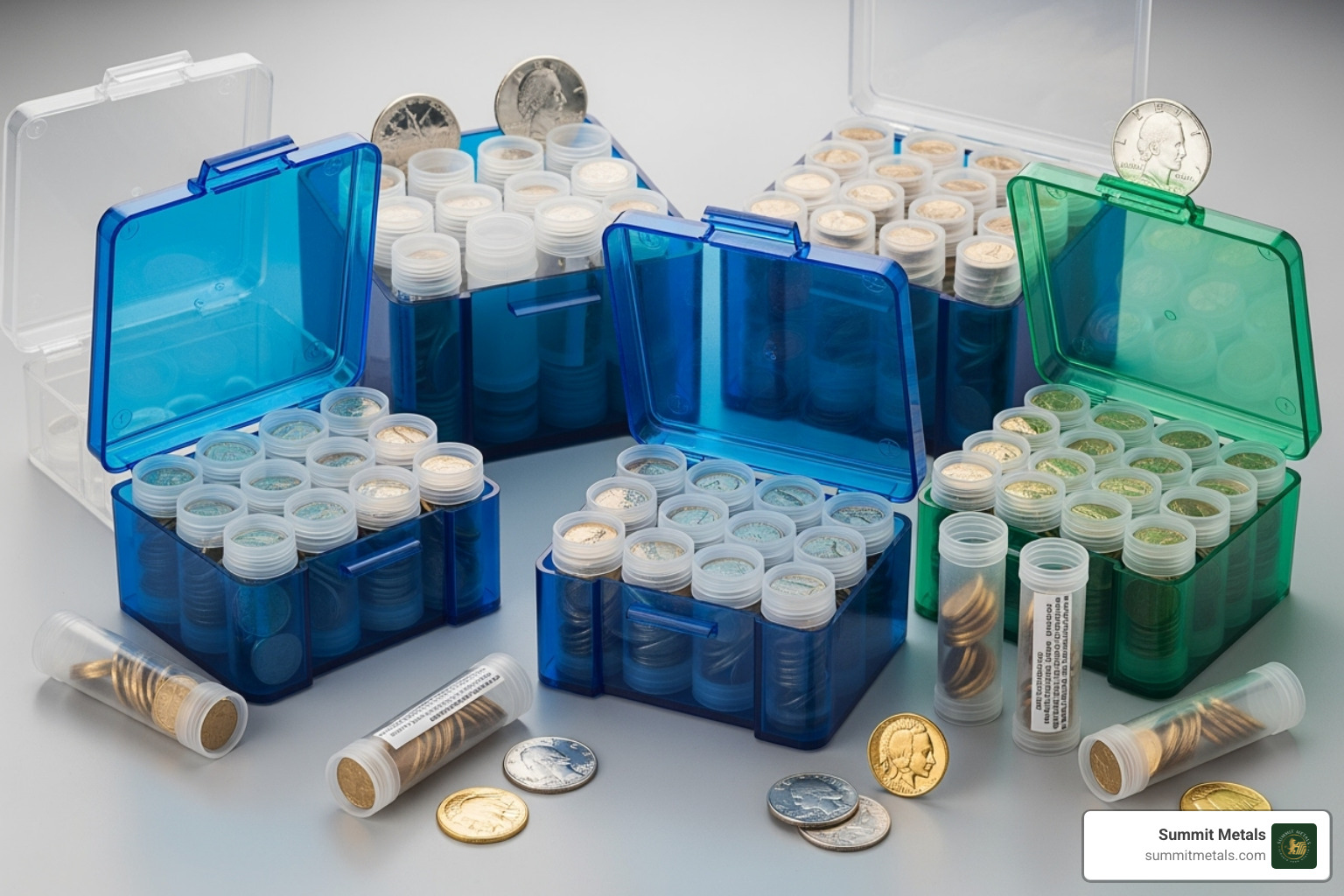
Monster Boxes are reinforced plastic containers designed by mints to hold 500 one-ounce bullion coins, keeping them organized and protected. Coin Tubes, also from mints, are precision-sized to hold a roll of coins (usually 20-25), preventing movement and surface damage.
Intercept Technology Boxes offer a leap in protection. The Intercept Technology© Box SL 25, for example, uses a special lining to purify the air, neutralizing corrosive elements for up to 15 years. This is ideal for high-value graded coins.
For investors using consistent strategies like Autoinvest—which allows you to dollar-cost average by buying metals monthly, like a 401k—secure storage is paramount. Summit Metals provides the assets and the knowledge you need with our Top Tips for Precious Metals Storage: Secure Your Investments.
Choosing Between Coins and Bars
Both coins and bars are excellent ways to own physical metal. Here’s a comparison to help you decide:
| Feature | Coins | Bars |
|---|---|---|
| Liquidity | Excellent. Smaller denominations are easy to sell globally. | Very Good. Larger bars may require specific buyers. |
| Security | Superior. Government-issued with a face value and anti-counterfeiting features. | Good. Rely on serial numbers and assay marks, which can be counterfeited. |
| Premium | Higher, due to minting costs and legal tender status. | Lower, especially for larger sizes. More metal for your money. |
| Portability | Excellent. Small, easy to transport discreetly. | Fair. Larger bars are heavy and less discreet. |
| Storage | Good. Require slightly more space than bars. | Excellent. More compact and stackable for the same weight. |
| Privacy | Good. Smaller transactions are often more private. | Fair. Large transactions may trigger reporting requirements. |
The choice depends on your goals. At Summit Metals, we provide transparent, real-time pricing to ensure you get the best value, whether you choose coins or bars.
Frequently Asked Questions about Metal Storage Containers
We hear these questions all the time from clients exploring metal storage containers. Here are answers to the most common concerns.
How do you maintain a metal storage container?
Maintaining a metal container is simple and prevents major issues. A little regular attention goes a long way.
- Inspect for Rust: Every few months, check seams, welds, and scratches. Clean any surface rust with a wire brush and touch it up with a rust-inhibiting primer and paint.
- Lubricate Moving Parts: Twice a year, apply lubricant to door hinges and locking mechanisms to keep them operating smoothly.
- Check Seals: Regularly inspect the rubber door gaskets for cracks or gaps. A good seal is essential to keep the container wind and water tight.
- Clean Spills Promptly: Clean up any spills or standing water inside to prevent corrosion and damage.
- Ensure Level Ground: For large containers, an uneven surface can twist the frame and cause door problems. Use blocks or shims to keep it level.
Are metal storage containers environmentally friendly?
Yes, metal storage containers are a sustainable choice for several reasons:
- High Recyclability: Steel and aluminum can be recycled indefinitely without losing quality. Steel is the most recycled material on Earth.
- Long Lifespan: A metal container can last for decades, reducing the waste associated with replacing less durable plastic or wood options.
- Eco-Friendly Finishes: Modern powder coating produces fewer volatile organic compounds (VOCs) than traditional liquid paint, reducing air pollution.
- Recycled Content: Many containers are made from recycled steel or aluminum, further reducing their environmental impact.
What are the rules for placing a large storage container on my property?
Do your homework before the container arrives. Regulations vary by location.
- Local Zoning Laws: Check with your city or county planning department about rules for temporary or permanent structures. They dictate size, placement, and duration.
- Homeowner's Association (HOA) Rules: If you're in an HOA, review your covenants. They often have stricter rules than the city and may prohibit containers or dictate their appearance.
- Permit Requirements: Many jurisdictions require a permit, especially for long-term placement. This may involve submitting a site plan.
- Setback Requirements: Most areas require structures to be a certain distance from property lines, sidewalks, and other buildings.
A quick call to your local planning department can save you from fines and the hassle of moving a multi-ton container.
Secure Your Assets for the Future
Whether you're protecting industrial equipment, organizing a home, or safeguarding investment-grade bullion, the right metal storage container is crucial. We've explored the landscape of metal storage, from massive shipping containers to specialized boxes for precious metals.
The core advantages are clear: durability, security, weather resistance, and longevity. These benefits ensure your assets remain protected year after year. For business owners, this means choosing a container custom to your operational needs, whether it's a refrigerated unit or a heavy-duty stillage bin.
For precious metals investors, the stakes are even higher. Standard containers are not enough. Investment-grade metals deserve purpose-built protection with anti-corrosion linings and climate stability. This is where our expertise at Summit Metals is invaluable.
Building wealth through physical metals requires consistency, which is why we created Autoinvest. This program allows you to dollar-cost average your purchases monthly, just like a 401k. But this strategy only succeeds if your growing portfolio is properly secured.
My experience, from Wall Street to helping everyday investors, has taught me that protection is as important as acquisition. A brilliant investment strategy crumbles without proper storage. Understanding how to store your assets correctly is part of the investment itself. Armed with this knowledge, you can choose the right solution and sleep soundly knowing your assets are secure.
Ready to take the next step in protecting your precious metal investments? Explore our complete guide to IRA Storage, where we dive deeper into specialized storage solutions for retirement accounts and long-term wealth preservation.
